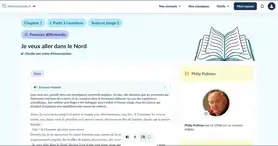Unit 15
Activity 1
A history of retelling
Ressource affichée de l'autre côté.
Faites défiler pour voir la suite.
Faites défiler pour voir la suite.
Text
Considered by many to be the godfathers
of modern fairy tale lore, the Grimm brothers collected a wealth of German folklore and published
the stories in an anthology. Many of the stories
were exceedingly dark and violent, but kids read
them anyway. The books retained their popularity
surprisingly well, and in the 20th century, a large
portion of the tales was thought to be too dark
and violent for children. So, when Disney pulled
inspiration and storylines from the Grimm's tales,
they deliberately chose to overlook the allusions
to sexuality, as well as the descriptions of overt
violence and cruelty that were present in so many
of the fables. This left us with the sanitized, moralistic good-triumphs-over-evil stories that we know
so well today.
But the kids who once dreamt of the Disney versions of fairy tales have grown up now. Today, they are the story weavers, working on blockbuster movies and writing the hit television shows like Once Upon a Time. And so we are seeing the retelling of old German folktales in shows like Grimm, a story that features the Grimm brothers as cops, fighting modern, real-life versions of familiar fairy tale creatures. Hansel and Gretel are now cunning Witch Hunters rather than helpless, abandoned children.
So what is it that drives us to modernize these tales? Many times, we choose to reimagine characters like meek, fragile Snow White or little, gullible Jack from Jack and the Beanstalk as characters who are now powerfully in control of their destinies - presently, they are unlikely heroes at worst and completely badass action heroes at best. In some of the new stories the women, who were formerly relegated to droll, feminine passivity, have advanced to meet their male counterparts as equals in battle: […] Today, people who grew up with the same old narrative of prince-meets-princess-and-they-live-happily-ever-after are creating worlds where our childhood heroes can be as powerful, flawed, and as nuanced as we always wanted them to be. And the whole point of fairy tales is to pass on these timeless stories to the next generation, even if it's in an updated format, isn't it?
But the kids who once dreamt of the Disney versions of fairy tales have grown up now. Today, they are the story weavers, working on blockbuster movies and writing the hit television shows like Once Upon a Time. And so we are seeing the retelling of old German folktales in shows like Grimm, a story that features the Grimm brothers as cops, fighting modern, real-life versions of familiar fairy tale creatures. Hansel and Gretel are now cunning Witch Hunters rather than helpless, abandoned children.
So what is it that drives us to modernize these tales? Many times, we choose to reimagine characters like meek, fragile Snow White or little, gullible Jack from Jack and the Beanstalk as characters who are now powerfully in control of their destinies - presently, they are unlikely heroes at worst and completely badass action heroes at best. In some of the new stories the women, who were formerly relegated to droll, feminine passivity, have advanced to meet their male counterparts as equals in battle: […] Today, people who grew up with the same old narrative of prince-meets-princess-and-they-live-happily-ever-after are creating worlds where our childhood heroes can be as powerful, flawed, and as nuanced as we always wanted them to be. And the whole point of fairy tales is to pass on these timeless stories to the next generation, even if it's in an updated format, isn't it?
“Happily Ever After?: Modernizing Fairy Tales For a New Generation”, Heather Ewert, 2010.
Ressource affichée de l'autre côté.
Faites défiler pour voir la suite.
Faites défiler pour voir la suite.
Questions
Path A
1-A
List the adaptations.2-A
What is the target audience?
3-A
List the adjectives used to define them.Path B
1-B
List the original fairy tales.2-B
What was the target audience?3-B
List the adjectives used to define them.Let's talk this out!
Group work
Mediation
4
What are the differences between the original and the modern versions?
5
Why do people want to modernise fairy tales? What impact could it have on the next generation?
Useful vocabulary
People are nostalgic / like remembering the past so…
They expect a movie to be… They don't believe in…
Ressource affichée de l'autre côté.
Faites défiler pour voir la suite.
Faites défiler pour voir la suite.
Present perfect
Observez les verbes en gras dans le texte.- Comment sont-ils formés ?
- Quelle différence y a-t-il avec
la forme soulignée ?
•
Ressource affichée de l'autre côté.
Faites défiler pour voir la suite.
Faites défiler pour voir la suite.
La prononciation de « have »
- Quand c'est un verbe : I have /ˈhæv/ a collection of fables.
- Quand c'est un auxiliaire : I have /həv/ read Cinderella.
Ressource affichée de l'autre côté.
Faites défiler pour voir la suite.
Faites défiler pour voir la suite.
Over to you!
Ressource affichée de l'autre côté.
Faites défiler pour voir la suite.
Faites défiler pour voir la suite.
Une erreur sur la page ? Une idée à proposer ?
Nos manuels sont collaboratifs, n'hésitez pas à nous en faire part.
j'ai une idée !
Oups, une coquille

